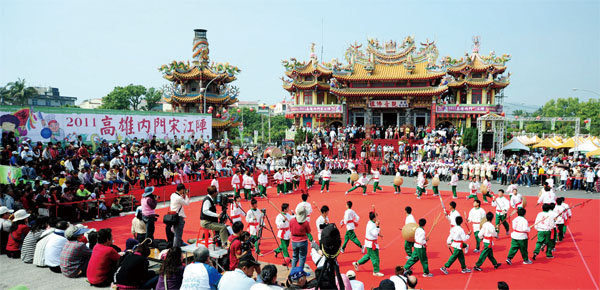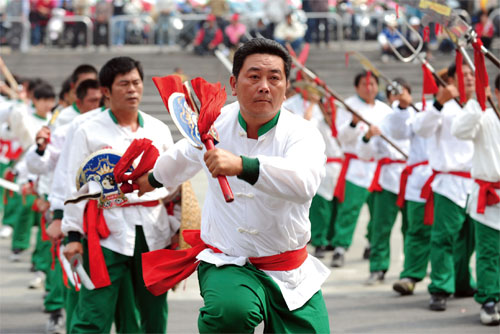The 2011 Neimen Songjiang Battle Array in Kaohsiung / 2011高雄內門宋江陣
The 2011 Neimen Songjiang Battle Array in Kaohsiung
◎English written by Lin Fang-ju
◎Photos by Kang Cun-cai, Pao Chung-hui, Tsai Yi-jen, Hou Ya-ting
 Neiman's Guan Yin Birthday Festival is held annually from March 12-21. Each day crowds gather in front of the Nan-Hai Zih-Jhu temple, to watch Text and Armed Array performances. Text Arrays are more instrumental, whereas Armed Arrays include Kung Fu, dance, rhythmic drumming, martial arts and weapon drills. At the other side of the temple, more traditional performances are dedicated to Guan Yin.
Neiman's Guan Yin Birthday Festival is held annually from March 12-21. Each day crowds gather in front of the Nan-Hai Zih-Jhu temple, to watch Text and Armed Array performances. Text Arrays are more instrumental, whereas Armed Arrays include Kung Fu, dance, rhythmic drumming, martial arts and weapon drills. At the other side of the temple, more traditional performances are dedicated to Guan Yin.
Approximately forty troupes contribute 80 Songjiang Battle Array performances .These include both Text and Armed Arrays, some of the most famous being the Songjiang, Lion and Dragon Battle Arrays. Text arrays include the Chariot and Drum Parade and Jumping Drum Dance. Celebrations also included competitions, a Guan Yin Pilgrimage and exquisite delicacies such as Neiman's own Luohan soup. (The soup is made from twenty ingredients, with complicated cooking process and is believed tastes best with rice.)
The host of the Songjiang Battle Array spoke entirely in Taiwanese describing its cultural significance, performance characteristics and troupes' backgrounds. All performances were unforgettable, with skillful martial arts and the dazzling audiovisual effects of the Songjiang Battle Array. Among Neiman's most famous arrays is the "Hengshan Songjiang Battle Array". The Tourism Bureau rates this festival as one of the top twelve in Taiwan. Neiman's performances have been held annually for 10 years and offer a variety of arrays.
Neiman is known for its barren landscape, notorious highland, Area 308 and Moonscape Scenic Area located at the Neiman, Kaohsiung and Tainan, Zuozhen junction. The area was previously impoverished due the ground's high salt content. Poverty subsequently brought about high crime, which the government couldn't control. This forced villagers to take protection into their own hands by hiring security guards and practicing various forms of martial arts. This traditional form of self-defense was later incorporated into performances of the famous Chinese novel, Water Margin. Martial arts were also incorporated into Guan Yin worship and became known as the "Songjiang Acts". Later it evolved into the Songjiang Battle Array. Every year on Guan Yin's birthday (February 29th of the lunar calendar) local groups, schools and battle troupes participated in a pilgrimage. It is believed Guan Yin will see the results of their hard work, visit the villages and witness their birthday wishes.
Neiman is famous for village folk art, which is taught in its elementary schools. Lin Yi-an (Administrative Director of Neiman Elementary School), explains adults focus on the artistic side of the performances, whereas children learn teamwork. All get a deeper understanding of their local culture, art and cooperation in promoting community activities. Director Lin grew up in Neiman and understands how rich and diversified its culture is. Director Lin points out the young people of Neiman are proud of their heritage and culture.
Neiman residents take a great amount of time to hone their martial arts maneuvers. Hengshan Songjiang Battle Array now has a brand new rehearsal center, built with donations from villagers. An array cast requires up to 60 people. The essence of the Songjuang Battle Array is captured in the martial arts, solid movements, dexterous jumps, solid deep knee bends and perfect turns. The martial artists' posture demonstrates their commitment to the production. During the festival, work comes to a halt in Neiman and people living outside, return home. The productions also demonstrate unity and cooperation.
2011高雄內門宋江陣
◎文/侯雅婷、蔡乙甄
◎攝影/康村財.鮑忠暉.蔡乙甄.侯雅婷
 即使是非假日來到高雄內門南海紫竹寺,廟前廣場的人潮,仍按照表演活動的表定時間,聚集到舞台周圍,全都聚精會神地觀賞著表演。在這裏看熱鬧是件有趣的事,主舞台的文陣(演奏樂器)和武陣(身體的韻律)輪番登場,寺廟的對面,還搭起戲棚子,主角接連賣力演出,要將最精采的演出獻給觀音佛祖。
即使是非假日來到高雄內門南海紫竹寺,廟前廣場的人潮,仍按照表演活動的表定時間,聚集到舞台周圍,全都聚精會神地觀賞著表演。在這裏看熱鬧是件有趣的事,主舞台的文陣(演奏樂器)和武陣(身體的韻律)輪番登場,寺廟的對面,還搭起戲棚子,主角接連賣力演出,要將最精采的演出獻給觀音佛祖。
今年的宋江陣於南海紫竹寺熱鬧登場,從三月十二日至二十一日為期十天的活動期間,有文武陣頭大匯演、大專創意宋江陣大賽和觀音佛祖遶境等內容。近四十個地方文武陣頭,活動期間演出共計八十場次,除了傳統的武陣「宋江陣」、「獅陣」、「龍陣」,還有平時較少欣賞到的文陣,包括「車鼓陣」、「跳鼓陣」。除了讓觀眾大飽眼福之外,堪稱「總舖師原鄉」的內門,更精心準備深具在地特色的「功夫菜」供訂桌享用,現場還有「羅漢飯湯」讓民眾隨喜添香油錢來一嚐滋味。羅漢飯湯是內門的在地料理,料理過程可是一點也不馬虎,光是食材就有20多種。負責煮食的總舖師「阿机師」机義雄強調,「羅漢飯湯」一定和著米飯吃,這樣才能吃出湯頭的好滋味。
宋江陣現場主持人全程以台語播音,賣力的說明宋江陣相關的文化背景及各隊精彩的表演。只見武陣上場時,伴隨著節奏分明的鼓聲,虎虎生威的功夫更顯俐落。習武者操演著手中的兵器,同時運功間自然發出的喝喝聲,再加上快速地變換隊形,彷若武俠小說中的功夫過招,步履既輕巧且威重,習武者個個身手非凡,用嘆為觀止來形容也不為過。從視覺到聽覺一一征服前來觀賞的看倌們,就是這樣萬分精采的宋江陣,被交通部觀光局列為台灣十二大節慶之一。自2001年舉辦迄今,已邁入第11屆,變化多端的陣式饒富地方特色,累積內門宋江陣的能量和豐富性,打開內門宋江陣在台灣的高知名度。
內門地區以「惡地」地形聞名,特別是在高雄內門區和台南左鎮區交界處的月世界308高地最為明顯,因土壤含鹽分高,不利糧食作物生長,所以先民生活困苦、盜匪猖獗,加上官府鞭長莫及,迫使各村落自組守衛隊,演練各種武藝,以抵禦外侮。演變到後來,這項早期為了保鄉護民的地方武術,因內門地區以觀音佛祖為信仰中心,為了配合遶境,居民在武術中融入中國著名俠義文學名著「水滸傳」的戲劇表演,排練成「宋江戲」,進而演變成「宋江陣」。每逢農曆二月十九日觀音佛祖誕辰,區內各庄頭、學校、陣頭都會參與遶境,演練完整的團練成果給佛祖觀賞,要向觀音佛祖報告:「我們已經準備好了,請看我們的團練成果吧!」除了請觀音佛祖驗收之外,也表達祝壽之意。
有「藝陣之鄉」美名的內門,傳承技藝的精神,從當地小學就能感受到。內門國小林義安主任表示,有別於成人著重「技藝」,國小學童們學習宋江陣首重「團隊精神」、認識自己的文化和藝術,同時鼓勵小朋友參與社區活動。林主任也是內門人,因深刻了解家鄉的文化如此豐富多元,自異地返鄉服務時,便投入推廣內門文化。就如同林主任所言,當內門子弟被問起是哪裏人?現在會很驕傲的答道:「我是內門人。」內門文化的軟實力讓內門人建立自信。
在內門眾多武陣中,「橫山宋江陣」可說是名氣響亮的一支隊伍,他們很幸運地在鄉親募款的支持下,買地蓋了道館,擁有了固定練習的場域。館主東三元表示,完整的演練一套橫山宋江陣約需60人,而據一位師兄表示,觀賞宋江陣的精髓可觀察武者的精神和每個動作的到位程度。跳躍的靈巧和馬步的紮實,轉折拿捏的恰到好處,從他們架勢十足的表演不難看出師兄口中持之以恆的練習成果。另一位師兄則表示,為了內門宋江陣活動,居民放下手邊的工作,在外地生活的內門人甚至還請假回故鄉,所有人團結合作,為了呈現最精彩的演出。